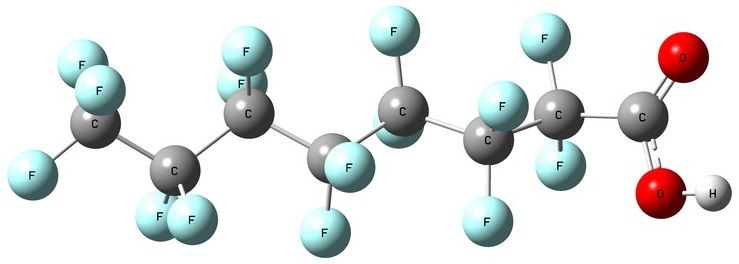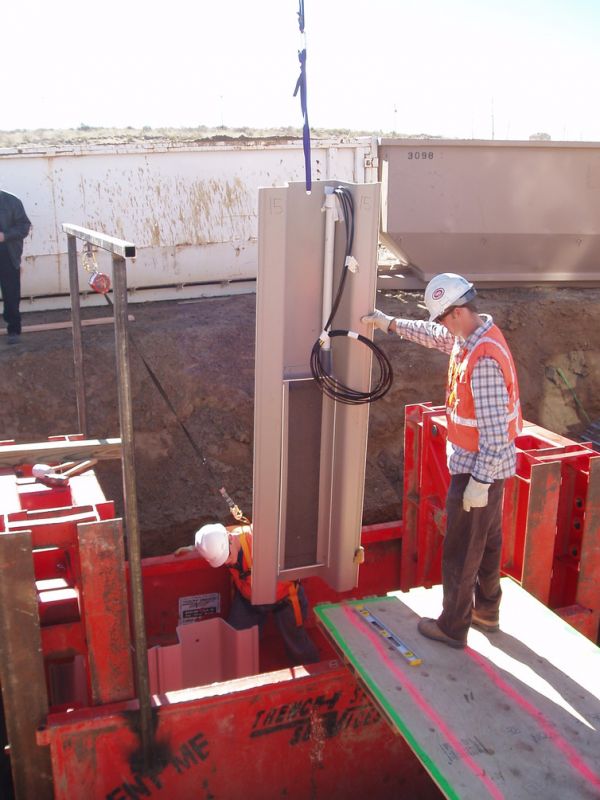Breaking PFAS in Groundwater with Electrochemical Oxidation
Published on by Marina A, Previously Key Account and Content Manager at AquaSPE AG in Technology
Electrochemical oxidation in combination with biological degradation shows the most promising results in removing PFAS from groundwater.
Per- and polyfluoroalkyl substances (PFAS) are a group of substances resistant and repellant to heat, water and oil.

Image: Perfluorooctanoic acid (PFOA), one of many PFAS molecules.
They are often used in firefighting foams, waterproof fabric, food packaging…
Them being extremely useful and widely applied has led to contamination of public water systems.
PFAS can cause reproductive, developmental, and systemic effects in laboratory tests.
They resist degradation in nature and bioaccumulate in wildlife and humans.
Long-chain PFAS are generally more dangerous and toxic so manufacturers are replacing them with smaller molecules since they accumulate less but they spread faster.
Removing PFAS from the environment is a challenging task. The chemical bonds between fluorine and carbon are extremely strong, which is the backbone of PFAS molecule.
They can be filtered out of the water but that is not a real and practical solution since the filters then have to be disposed to a specifically designed area for this so the PFAS are technically just transported to another location.
To remove PFAS from water, electrochemical oxidation has been proven as the most efficient method.
The current is passed through the water between the electrodes.
With sufficient voltage, PFAS molecules give up an electron to the positive electrode, which turns the PFAS into CO2 and fluoride in a chain reaction.
The electrodes and conductive metal plates usually made of titanium, tin and others metal oxides. The surface coating is the main determinant of how fast they degrade the contaminants.
Electrodes of titanium mesh coated with a mixture of iridium and tantalum oxides are affordable but very slow at degrading PFAS. On the other hand, tin oxide-coated mesh electrodes work much better but are expensive.
Removing the PFAS from water with electrochemical oxidation is easy to achieve in the lab but challenging in the environment.
 Usually getting rid of PFAS from the environment means removing them from groundwater.
Usually getting rid of PFAS from the environment means removing them from groundwater.
However, they are built up in the soil and slowly released and since PFAS contain carbon groundwater cleanup by pumping it to the surface through a reactor to clean it can take decades.
Treating PFAS underground is faster and more economically viable.
Electrolytic barriers can be used as a way of treatment of groundwater. They require 5-15 V (as much as a car accumulator produces).
The source of their electricity could be solar panels and electrolytic barriers, if handled properly, can be used for several years.
A species of wood-rotting fungus in combination with electrolytic oxidation has shown as the best promising method for water treatment.
The fungi need oxygen which is created by breaking down the organic contaminants in groundwater. The fungi then transform some of the PFAS.
This speeds up the treatment while allowing the current to be lowered, saving energy, electrode life and biproducts formation.
Media
Taxonomy
- Oxidation
- Electrolosis
- Polluted Water Oxidation
- Wastewater Treatment
- Water Treatment Solutions
- Groundwater Pollution
- water treatment